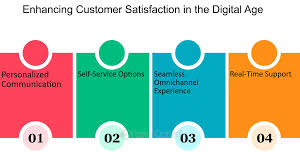Today’s hyper-connected world has seen customer expectations change at an alarming rate. Consumer empowerment in the era of digital Consumers have more options, information, and ways to express their views than ever before. For businesses, this involves making rapid adjustments or potentially facing customer churn.
Keeping customers happy is no longer a nice-to-have, rather, it’s a business necessity. From real-time assistance to customized experiences, people expect more, faster. This article delves into the best practices that organizations can adopt to not only meet but exceed customer expectations in the digital era. We also explore how the future of sales, shaped by AI, data analytics, and automation, is directly influencing customer satisfaction.

1. The Digital Customer Experience Landscape
The digital transformation has redefined how brands interact with customers. According to Salesforce, 88% of customers say the experience a company provides is as important as its products or services.
Key Challenges
- Fragmented communication across platforms
- Rising customer expectations for speed and accuracy
- Real-time feedback loops through social media and reviews
Key Opportunities
- Leveraging digital tools to offer seamless, personalized service
- Using customer data to predict and fulfill needs proactively
2. Embracing Omnichannel Communication
Customers now interact through multiple platforms—email, chat, social media, mobile apps, and more. Businesses that create a seamless omnichannel experience significantly increase customer retention and satisfaction.
Best Practices:
- Integrate communication tools to provide a unified customer profile.
- Ensure consistency of information across all touchpoints.
- Allow customers to switch between channels without losing context.
Stat: Companies with strong omnichannel customer engagement retain on average 89% of their customers (Aberdeen Group).
3. Leveraging AI for Personalization and Support
Artificial Intelligence is transforming customer service by enabling faster, more personalized interactions. From chatbots to predictive recommendations, AI allows businesses to scale customer support without sacrificing quality.
Applications of AI:
- Chatbots and Virtual Assistants: 24/7 support with quick query resolution
- Product Recommendations: Personalized suggestions based on behavior and history
- Predictive Customer Service: AI predicts issues and resolves them proactively
Example: Sephora uses an AI-powered chatbot on Facebook Messenger to recommend products, boosting both engagement and sales.
4. Harnessing Data Analytics for Deeper Insights
Data is the new currency. With advanced analytics, businesses can gain a 360-degree view of customer behavior, preferences, and satisfaction levels.
How to Use Data Analytics:
- Customer Feedback Analysis: Use sentiment analysis to evaluate feedback.
- Churn Prediction Models: Identify at-risk customers and re-engage them.
- Customer Journey Mapping: Understand every touchpoint and optimize the experience.
Insight: Companies that utilize customer behavioral insights outperform peers by 85% in sales growth (McKinsey).
5. Automating Responsiveness Without Losing the Human Touch
Automation can improve efficiency, but customers still crave human connection. Balancing automation with empathetic human support is key.
Automation Best Practices:
- Automate repetitive tasks like order tracking and appointment scheduling.
- Use AI to assist, not replace, human agents.
- Offer easy escalation from bots to human representatives.
Tip: Always provide a “talk to a human” option in your support flows.
6. Building Trust Through Transparency and Security
Digital customers are increasingly concerned about how their data is used. Building trust requires transparency and robust data security.
Strategies for Building Trust:
- Be clear about data collection and usage policies.
- Invest in cybersecurity and compliance certifications (e.g., GDPR, CCPA).
- Use secure channels for communication and transactions.
Data Point: 73% of consumers say trust in a brand matters more than it did a year ago (Edelman Trust Barometer).
7. Investing in Employee Training and Empowerment
Happy employees create happy customers. Empowering frontline staff with the right tools and training can significantly improve service quality.
Employee-Centric Practices:
- Provide training on digital tools and customer empathy.
- Encourage a customer-first culture.
- Recognize and reward excellent customer service.
Fact: Companies with highly engaged employees outperform their peers by 147% in earnings per share (Gallup).
8. Measuring and Monitoring Customer Satisfaction
What gets measured gets managed. Tracking customer satisfaction through key metrics helps identify areas for improvement.
Important Metrics:
- Net Promoter Score (NPS): Measures loyalty and likelihood of referral
- Customer Satisfaction Score (CSAT): Gauges short-term satisfaction
- Customer Effort Score (CES): Evaluates ease of customer experience
Pro Tip: Use real-time dashboards to monitor trends and respond promptly.
In the digital age, customer satisfaction hinges on delivering seamless, personalized, and secure experiences across every touchpoint. Leveraging the future of sales driven by AI, data analytics, and automation empowers businesses to exceed customer expectations and foster long-term loyalty.
Companies that embrace these best practices will not only survive but thrive in the competitive digital marketplace. Remember: satisfied customers are your best brand ambassadors.
Frequently Asked Questions (FAQ)
Q1: Why is customer satisfaction more important in the digital age?
A: Because customers have more choices and louder voices online, a single poor experience can quickly escalate and damage brand reputation.
Q2: How can small businesses use AI to improve customer satisfaction?
A: Start with affordable AI tools like chatbots or CRM plugins that offer personalized recommendations and support.
Q3: What is the role of data analytics in customer satisfaction?
A: It helps businesses understand behavior, predict needs, and tailor services for a more engaging and effective customer experience.
Q4: Is automation replacing human customer service agents?
A: No, it’s augmenting them. Automation handles repetitive tasks, allowing human agents to focus on more complex, emotional issues.
Q5: How do I measure customer satisfaction effectively?
A: Use a combination of NPS, CSAT, and CES scores, and gather feedback through multiple channels for a holistic view.